Building the Real Iron Man
While audiences flood theaters this month to see the comic-book-inspired Iron Man, a real-life mad genius toils in a secret mountain lab to make the mechanical superhuman more than just a fantasy with the XOS Exoskeleton
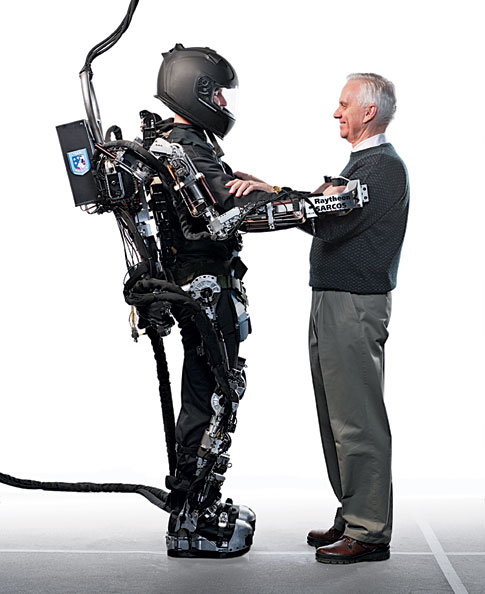
Afghanistan. A hidden bunker. Four men with rifles guard a thick, rusted steel door. Bam! A huge fist pounds against it—from inside. Bam! More blows dent the steel. The hinges strain. The guards cower, inching backward. Whatever’s trying to break out is big. And angry.
The door flies open, and a metallic giant bursts through. It looks like a robot but, hidden inside, famed weapons designer Tony Stark maneuvers the mechanical beast. Bullets bounce off the suit, barely denting his armor. He levels the guards with one swat. Outside, he stares down the enemy camp around him, switches on the flamethrowers in his arms, and roasts the joint.
Utah. A secret mountain lab. Software engineer Rex Jameson backs into a headless metal suit that’s hanging from a steel I-beam by a thick rubber cord. He clicks into the aluminum boots, tightens belts across his legs and waist, and slides his arms through backpack-like straps, gripping handles where hands would be. It looks as easy as slipping into an overcoat.
Then he moves, and the machine comes to life, shadowing his every motion. He raises his fists and starts firing sharp jabs while bouncing from one foot to the other. He’s not quite Muhammad Ali, but he’s wearing 150 pounds and he looks light.
He could easily knock a nearby coder to the floor, or fling one over a desk—but even more impressive, he could do it all day. To show off his superhuman endurance, he walks over to a weight rack and yanks down a bar loaded with 200 pounds. Then he does it again. And again. He stops somewhere around 50, but he’s been known to rip through 500 reps in a row. Even then, he quits out of boredom, not fatigue.
It’s fantasy versus reality, and the spread is shrinking. The latter, the XOS, is the latest and arguably most advanced exoskeleton in existence, developed by one-man idea factory Steve Jacobsen and the engineers at Sarcos, a robotics company he started in 1983 that was recently purchased by the defense giant Raytheon. The flame-throwing monster? That’s the star of the superhero blockbuster Iron Man, due out May 2. The film follows a prolific inventor named Tony Stark who builds a robotic suit of armor that grants him fantastical abilities. Iron Man has been thriving in comics for more than four decades, but this is Hollywood’s first go at the story. And the timing couldn’t be better. Not only is Iron Man—a hero born of pure engineering—the perfect idol for our gadget-obsessed era, but for the first time since the character appeared, the suit is more than just an illustrated dream.
In the past seven years, a handful of engineers have taken the military’s 40-year-old fantasy of mechanically enhanced soldiers that can carry heavy loads and begun to make it real. Funded with millions from the Pentagon’s Defense Advanced Research Projects Agency (Darpa), Jacobsen and others have finally begun marrying artificial muscles and control systems into suits that could soon be available to soldiers, firemen and the wheelchair-bound. There are still serious challenges—powering these wearable robots, for one—but Sarcos’s XOS, the most capable full-body suit, one that moves seamlessly with its wearer, has even the comic’s creators feeling like the real world is catching up to their vision. After Adi Granov, one of the main illustrators of the comic and a consultant to the film, watched a clip of the suit in action, he was startled. “I knew that’s where we were heading, but I didn’t realize we were this close,” Granov says. Aside from the lack of flight and weapons, he adds, “that’s Iron Man.”
Check out video of the XOS in action here, and for a brief photo history of the man-made exoskeleton, see our gallery here. Continue reading this feature below.
From Marvel to Machine
If you want to untangle the technological roots of the fantasy against which any real exoskeleton will be compared, you need to visit the place where the comic evolved: the Midtown Manhattan headquarters of Marvel, Inc. There, Tom Brevoort, the editor who oversees the Iron Man comics, gives me a short biographical summary of Tony Stark: MIT grad, superstar scientist and engineer, heir to a fortune, womanizing alcoholic. The story of how he becomes Iron Man has changed over the years, but the basic idea, and the one the movie has adopted, is that some bad guys take him hostage and demand that he build them a killer weapon. He constructs a suit of armor instead and, after escaping, resolves to improve both the suit and himself, transforming from an immature brainiac into a true superhero.

Look, One Hand
Iron Man can outrace a jet, dead-lift 1,000 tons, hack into high-security computers, and do it all through a direct brain interface. Far-fetched? Sure, but Brevoort says that’s the point. “Iron Man’s always got to be three steps ahead of the best things you’ve got, or he’s a fossil.”
When the character appeared in 1963, the best the military had was a concept on paper. That year, U.S. Army researcher Serge Zaroodny published a report describing his design for a wearable robot that would endow the operator with Hulk-like power, but the necessary technology didn’t exist to make it viable. Besides a few non-military designs [see timeline photo gallery here], the prospect of an actual super-suit languished until 2000, when Darpa began a seven-year, $75-million program called Exoskeletons for Human Performance Augmentation. By that time, a handful of exoskeleton champions—such as former Army colonel Jack Obusek, the director of human systems integration at the Natick Soldier Research, Development and Engineering Center in Natick, Massachusetts—believed that the technology had begun to catch up. Obusek, who has helped push for the military’s exoskeleton research since 1995, says the rise of smaller, more versatile sensors and faster microprocessors began to convince him and other officials that a wearable robot just might be buildable.
But Darpa’s ambitious wish list read like something from a comic: a machine that would let the average soldier lug hundreds of pounds and hike for days without fatigue, handle weapons that normally require two people, and whisk the injured off the battlefield by tossing one or two men on his back. They asked for the suit to support more armor, rendering men impervious to enemy fire. They even wanted it to make soldiers jump higher. They wanted Iron Man.
Some of the experts Darpa consulted before launching the program didn’t agree that this vision was realistic. “Half the people I talked to believed, almost as if it was a religious thing, and about half thought it was a complete waste of money, time and resources,” says Cornell University engineer Ephrahim Garcia, who led the Darpa program in its infancy. The naysayers were hardly crazy, he adds: “It was a huge challenge.” The exoskeleton would need a portable power system that could keep it running for up to a full day; small, powerful artificial muscles; and a complex control system that governed their actions. And it would need to be fast.
The exoskeleton would have to be the soldier’s mechanical shadow, reading his every motion—the left arm is swinging in this direction with this much force—and mimicking him almost instantly. Even the slightest lag would create a drag-like effect and make the operator feel as if he were moving through water. The machine would also need some way of reading forces applied across the suit thousands of times per second, plus microprocessors powerful enough to turn all that data into immediate directions for the robot’s limbs, so they could keep pace with the person inside.
Solving these problems, and figuring out how to combine the systems into a machine with the requisite speed, agility, strength and endurance, called for a real-world Tony Stark. But that turned out not to be a hotshot weapons designer. It was a guy who was building robot dinosaurs.
Check out video of the XOS in action here, and for a brief photo history of the man-made exoskeleton, see our gallery here. Continue reading this feature below.
Meet the Robot Maker
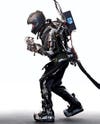
Beyond: Raytheon Sarcos XOS
Steve Jacobsen’s résumé makes him seem like the Willy Wonka of robotics—his projects over the past 35 years have spanned an 80-ton mechanized dinosaur and the Bellagio casino’s fountains. But he looks more professor than madman, tall with a board-straight back and perfectly groomed gray-white hair. Before introducing the XOS, he leads me on a tour of what he only half-jokingly calls his “tunnel of terror.” It could pass for a dentist’s office from the outside, but the cavernous space is the headquarters of the company he founded as an R&D arm of the University of Utah’s college of engineering, where he taught at the time. Although he’s built robots for some notoriously tough customers—he hints that Disney is just as demanding as the military—he’s still an academic at heart. He refers to his brain as a friend he likes to go off and spend time with, and he seems to care more about solving hard problems than about the solution’s ultimate application. After skipping right past a Ping-Pong-playing humanoid ‘bot, he lingers in front of a pair of singing, mechanical toucans he built for a local restaurant, marveling at how difficult it was to make them move like real birds. “We just do things we want to do because they’re interesting,” he says.
He talks in five-minute-long bursts on topics that range from expressions of wonder at the energy efficiency of biological systems (“Humans run on carrots!”) to reflections on engineering to starry-eyed platitudes (“Some things have to be believed to be seen”). But his chattiness belies a penchant for secrecy. He rarely talks to the press. He won’t tell me his age. As we walk though various labs, he’ll point to a device—a miniature unmanned ground vehicle, a new design for an exoskeleton leg—launch into an excited explantion, and then stop and ask me not to mention it. His reticence stems in part from the fact that several of his projects are military-funded. But there’s also a hint of the magician who’s not keen to reveal too many of his tricks.
The mix of Sarcos’s projects, which also include prosthetics and nanoscale motors, seems random. But Ephrahim Garcia says this versatility is part of what made Jacobsen uniquely suited to the exoskeleton challenge. He had proven skills in software and mechanical engineering, but he also had the unique ability to simply invent what he needed. “He can design the actuators. He can design the control system. He can design the machine and its components,” Garcia says. That kind of range was absolutely required.

How to Lift 200 Pounds Like It Was 2
“When you build something like an exoskeleton,” Jacobsen says, “there are about 25 subsystems, and they all have to work before you can go on to the next step. The two main objectives are strength and endurance, but it’s got to do 75 different things well.” Of all his robots, the XOS, because of the host of problems it presented, is clearly his favorite son. “None of them had a target like this. None of them had to have a self-contained system that has such strength, speed, endurance, flexibility.”
Check out video of the XOS in action here, and for a brief photo history of the man-made exoskeleton, see our gallery here. Continue reading this feature below.
An Exoskeleton is Born
In 2000, Sarcos applied for a piece of the Darpa money, in part because Jacobsen believed he had a solution for one of the biggest questions laid out in the original call for proposals: how the operator would interface with the robot. To confirm his hunch, Jacobsen asked the company’s staff photographer, Jon Price, if his daughter would help with a little experiment.
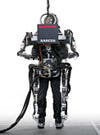
Rear View
The test called for Price to be, in effect, the exoskeleton, and his daughter to be the pilot. With her back to her father, she stepped up on his feet, her toes atop his. Then they held hands for balance and she began to walk. Price’s job was to stay in step, to keep his feet directly beneath hers. Within a few minutes, they were moving in sync. His daughter made all the high-level decisions—how fast to walk, when to turn—and Price just tried to mimic her, step for step.
The demonstration proved for Jacobsen that, given a few points of contact—the feet and hands, in this case—a smart machine could interpret the intended movements of the person strapped into it and react accordingly. On the way to the finished XOS, Jacobsen and his group designed compact actuators, built improved force sensors, invented more-efficient hydraulic valves, and even machined the robot’s aluminum feet. But what Jacobsen calls his “get out of the way” control scheme is the big idea that brings it all together, the approach that transformed it from just another of his cool robots into a superhero suit. Obusek, who has personally tried the XOS, agrees. “A human will fatigue fairly quickly even with very little resistance,” he says, but the XOS’s control system reduces that drag to nothing.
It’s that control that enables demo pilot Jameson to cruise through a workout without raising his heart rate. The instant he starts to pull down that weighted bar, sensors in each of his hand-grips register changes in torque. Without the exoskeleton’s help, the sensors would show that he was trying to pull down about 100 pounds in each hand. But the goal of the system, Jacobsen explains, is to get the force on those sensors as close to zero as possible; to let the XOS do the work. “The XOS carries itself,” he says, “and [Jameson] carries himself.”
Those hand-grip sensors, along with similar ones in the suit’s feet and back, feed measurements to a central processor hundreds and, for some of the sensors, several thousand times per second. The system runs these readings through a set of equations that governs the position and motion of the suit’s arms, legs and back. It recognizes that Jameson wants to bring his hands down and calculates what each artificial muscle in each of the joints needs to do to make the suit mirror him. Jameson never feels strain because the system instructs the robotic arms to grab the weight before he exerts any significant force. When he steps out of the XOS after a round on the weight machine, he’s not even out of breath. I ask him how he feels. “Fine,” he says, shrugging.
The suit Jameson has been using is roughly version 4.0. Jacobsen shows me a room where the first three models hang like mannequins. It reminds me so much of Iron Man’s “Hall of Armor,” where Stark keeps his suits, that I’m tempted to check the crime blotter in the area, see if there have been any instances of vigilante justice by a half-man, half-robot.
The first suit, built in 2002, didn’t even have power. The Sarcos team constructed it to prove that the exoskeleton would be able to move like we do. Jacobsen had one of the engineers strap in and try things like kicking a soccer ball, running, climbing into the tight cab of a bulldozer. This helped them determine that they had the right range of motion and the joints in the right places.
Getting those joints to open and close with the proper speed and power proved trickier. In 2003, Sarcos began working on hydraulically driven actuators to function as mechanical muscles. This approach isn’t revolutionary. In fact, says another exoskeleton builder, the suit’s reliance on hydraulics will be its downfall. One engineer, who declined to be named because he hadn’t seen the suit in person (its only public display is in a video shot by a local TV news crew that got uploaded to YouTube), said that a purely hydraulic system would waste too much power maintaining fluid pressure in the valves. Electric actuators could be better, he suggested, because the energy they use would be proportional to the action. But Jacobsen testily dismisses this critique. “Do you like the brakes on your car? Do you like the landing gear on a plane to work? Those are both hydraulic,” he says. Then he explains that he’s gotten around the energy-draw problem. Although he’s characteristically cagey about the details, he says Sarcos redesigned the valves that control the flow of the fluid to be more of an on-demand system, so they consume power only when the suit moves.
Despite its prowess in the weight room, the XOS hasn’t hit all the goals of the Darpa program. It won’t let you dunk a basketball or run any faster, and it won’t turn you into a Hercules. But one of the objectives of Darpa’s rigorous list of demands, Obusek says, was simply to see whether any of them would be possible. Of the three teams that took part in the project (Sarcos, Oak Ridge National Laboratory, and the University of California at Berkeley), the XOS emerged in 2005 as the suit closest to the agency’s initial vision. As a result, it is the only full exoskeleton the military has moved into the next development stage; Sarcos is now working under a two-year, $10-million Army grant.
Jameson steps back in for a final, relaxing workout, and as I watch this 150-pound robot mirroring his every move by way of just six points of contact, and consider the amount of data flowing around the suit every second to keep those actuators moving quietly and seamlessly, the whole scene seems as fantastic as the movie’s Iron Man. I half expect Jameson to blast off through the roof. But that’s not going to happen. For the XOS to bust out of this cave, they’re going to have to cut the power cord.
Check out video of the XOS in action here, and for a brief photo history of the man-made exoskeleton, see our gallery here. Continue reading this feature below.
The Other Power Players

Pant Suit
The world of exoskeleton researchers is small, secretive and a little catty. Even when they aren’t sure exactly how someone else’s suit operates, the builders aren’t afraid of lobbing keep-this-between-you-and-me digs at each other. The most common is some form of “Ask him how he’s going to power it.” The XOS and the two other leading exoskeletons in the U.S. have approached this critical question from opposite angles. Jacobsen decided to make an extremely capable suit first and figure out later how to power it for 4 to 24 hours, as Darpa mandated. During all the demos I watched, Jameson and the suit were tethered to a hydraulic pump that draws electricity from an external power supply. (The suit can operate from batteries, but only for 40 minutes at a time.) But the country’s other two top exoskeleton designers, Massachusetts Institute of Technology professor Hugh Herr and Homayoon Kazerooni of the University of California at Berkeley, began with the power problem.
Herr is trying to build a leg-powering machine that uses as little energy as possible—the first iteration draws a mere two watts, comparable to a portable radio—but can support 80 percent of an 80-pound load on a user’s back. In its current design, because of the way it affects his gait, the wearer burns slightly more energy with the suit than if he were just walking with the load alone. But Herr thinks that within the near future, he can improve the mechanics so that the machine actually saves the wearer effort. Ultimately, he envisions weekend warriors using exoskeletons as recreational tools, strapping in so they can run through the mountains all day. While Herr muses about these kinds of self-powered systems as a long-term dream, Kazerooni implies to me that he’s already part of the way there.
Kazerooni, another veteran of the Darpa program (neither he nor Herr has so far gotten additional money from the military beyond the original grant), says his Human Load Carrier (HULC) lower-body exoskeleton can operate for more than 20 hours without recharging. He says it allows the user to carry 100 pounds on his back and burn 15 percent less oxygen than if he was supporting the added weight alone.
Kazerooni’s device wasn’t ready for a public unveiling and, when pressed for details, would say only that the system is analogous to that of a hybrid car. Just as a hybrid uses the energy transferred during braking to recharge its battery, HULC capitalizes on the force transferred from the ground each time the user plants his weight on a different leg. The very act of walking keeps it juiced. He’s now in the middle of a three-year, $2-million grant from the National Institute of Standards and Technology to modify his system so it can help people with mobility disorders. “This isn’t just a war machine,” he says. “Our machine could replace the wheelchair.”
The closest competitor to the XOS is also a medical device, but on the other side of the Pacific, in Japan. Roboticist Yoshiyuki Sankai launched a company in 2004 called Cyberdyne (the same name as the firm that sparks the robot revolution in the Terminator films, incidentally) to market his full-body exoskeleton, now known as the Hybrid Assistive Limb, or HAL-5. Rather than using force sensors like the XOS, sensors in HAL-5 attached to the wearer’s skin pick up signals from his muscles to determine how he wants to move. The suit’s control system studies and then mimics a person’s natural gait. This means it takes up to half an hour for the suit and the operator to get in sync—you can’t just snap in and go. But since Cyberdyne sees the HAL-5 as both a rehabilitation device and nurse’s assistant, the training period may not matter. Strapped into the battery-powered suit, a hospital worker could hoist heavy patients as if they were kids. Sankai is leasing the suit to customers now.
Check out video of the XOS in action here, and for a brief photo history of the man-made exoskeleton, see our gallery here. Continue reading this feature below.
Breaking Free
In a recent Iron Man comic, the hero is lying beaten on the floor of his enemy’s lair, and the head-up display in his armored helmet feeds him the bad news—he’s almost out of power. But there’s still hope. He jams a finger through the concrete floor into a power line and quickly recharges his suit.
Unfortunately, real-world exoskeletons take more than a stolen jolt to power up, so the first XOS in the field may even be tethered. Obusek envisions this early version to be more of a workhorse than a warrior. A plugged-in suit, borrowing energy from a vehicle or a ship’s generator, could help a soldier rapidly unload a helicopter stacked with heavy equipment or repair tanks with broken tracks. Although the Army hopes to begin field-testing this version of the XOS by 2009, Jacobsen and company are still working toward an entirely self-powered version.
This summer, the company will launch a research program with an engine-design firm to develop a generator capable of powering the XOS for hours at a time. Jacobsen won’t tell me any more than that, but not just because he’s being coy. He’d rather talk about a more interesting challenge than building a robust power supply: cutting the suit’s appetite.
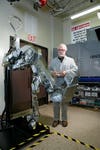
What a Kick
Jacobsen shows me a new, energy-saving leg that’s modeled on human propulsion. When we walk, we generate most of the power from the hip when we push off. Then, as the leg swings forward, the small muscles in our knees and elsewhere rest before making sure our feet hit the ground at the desired spot. That free-swinging technique saves energy. Kazerooni and Herr have already incorporated it into their legged exoskeletons, and Jacobsen is building it into the future version of his XOS. “The next step,” he says, looking ahead a few years, “is to get the power down to the point where we can walk using about one to three horsepower”—little enough to run on a portable power pack.
Jacobsen sees today’s version as a base vehicle that will eventually be modified to fit specific tasks, whether in health care, emergency response, maintenance or war. Future models could even operate autonomously. “You could get out and tell it, ‘Why don’t you go in that building, because I don’t want to,'” he says.
Later, walking through the Raytheon Sarcos lobby, I spot a few animated incarnations of this long-range vision rolling on a flat-screen TV. In the clips, armored soldiers throw heavy missiles on their shoulders, hurdle high walls, speed through combat rolls, even execute graceful backflips. Though encased in an XOS, they look as nimble as NFL cornerbacks. They look like Iron Man.
Contributing editor Gregory Mone has been reading Iron Man comics since he was 10 years old.
Check out video of the XOS in action here, and for a brief photo history of the man-made exoskeleton, see our gallery here.

1966: Hardiman

1979: Mobile Suit Gundam

1986: Aliens
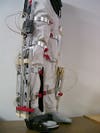
1987: Lifesuit
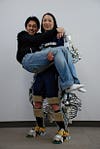
1990: Power Assist Suit
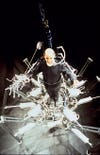
1998: Stelarc
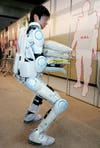
2002: HAL-3

2003: Matrix Revolutions
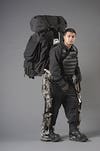
2004: Bleex

2008: Iron Man

Beyond: Raytheon Sarcos XOS